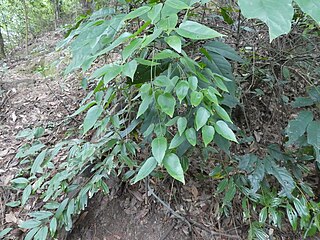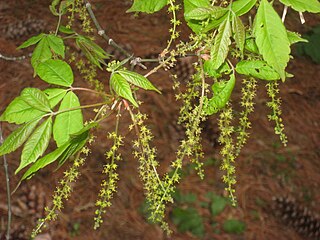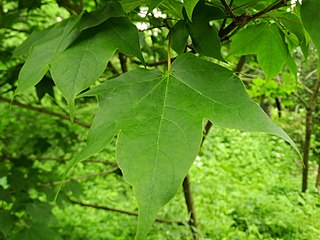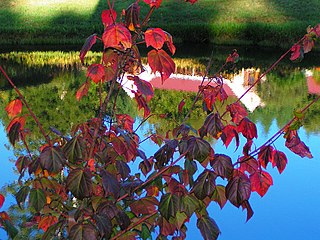
Carl Johann Maximovich, also Karl Ivanovich Maximovich was a Russian botanist. Maximovich spent most of his life studying the flora of the countries he had visited in the Far East, and naming many new species. He worked at the Saint Petersburg Botanical Gardens from 1852 as curator of the herbarium collection, becoming Director in 1869.

Acer griseum, the paperbark maple or blood-bark maple, is a species of flowering plant in the family Sapindaceae, native to central China. Acer griseum is found in the Chinese provinces of Gansu, Henan, Hubei, Hunan, Shaanxi, Shanxi and Sichuan, at altitudes of 1,500–2,000 m (4,921–6,562 ft).

Acer davidii, or Père David's maple, is a species of maple in the snakebark maple group. It is native to China, from Jiangsu south to Fujian and Guangdong, and west to southeastern Gansu and Yunnan.

Acer sterculiaceum, commonly known as Franchet’s maple or Himalayan maple, is a species of maple tree in the soapberry family. It is indigenous to Bhutan, northern India, and southwestern and central China.

Allium maximowiczii, English common name oriental chive, is an Asian plant species native to Siberia, the Russian Far East, Mongolia, Japan, Korea and northeastern China.
Fritillaria maximowiczii is a plant species known from northeastern China and eastern Russia.

Acer amplum is an Asian species of maple found in Vietnam and China.
Acer caesium, the Himalayan maple, is an Asian species of maple found in India, Pakistan, Nepal, and China.

Acer cordatum is an Asian species of maple. It has been found only in China.

Acer henryi is an Asian species of maple. It has been found only in China.

Acer longipes is an Asian species of maple. It has been found only in China.
Acer miaoshanicum is an uncommon Asian species of maple. It has been found only in southern China.

Acer pectinatum is an Asian species of maple that is native to the Himalayas and nearby mountains in southwestern China, Myanmar, and the northeastern part of the Indian Subcontinent. It is a spreading deciduous tree up to 20 m (66 ft) tall in the wild, with brown bark. The leaves are non-compound, leathery, up to 10 cm wide and 8 cm across, toothless, usually with 5 lobes but sometimes 3, the lobes toothed along the edges. The leaves of mature trees turn brilliant shades of yellow and orange before falling off in autumn.

Acer pictum, commonly known as yellow-paint maple, is an Asian species of maple. It widespread across much of China as well as Korea, Japan, Mongolia, and eastern Russia. Its natural habitat is in temperate forests.
Acer poliophyllum is an Asian species of maple. It has been found only in southwestern China.
Acer shenkanense is an Asian species of maple. It has been found only in China
Acer sutchuenense is an Asian species of maple. It is native to China.
Acer tenellum is an uncommon Asian species of maple. It is native to China.
Juncus maximowiczii is a species of plant in the genus Juncus, native to China, Korea and Japan. It grows in wet areas of mountains.










